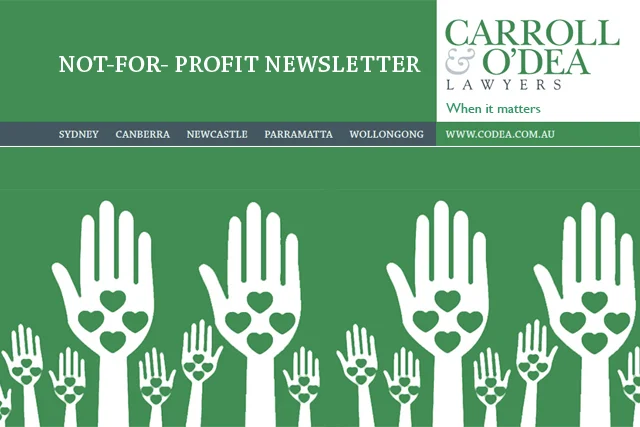
Not-For-profit Newsletter – January 2015
Published on January 14, 2015 by Josephine Heesh
Dear Reader,
Welcome to our first Newsletter for 2015.
As the New Year commences many of you will be returning to work from a break, but we wished to alert you to some ACNC activity especially the extension of time for lodgement of 2014 Annual Information Statements.
We look forward to another busy year with our Not-for-Profit and Charity clients during which time we hope the destiny of ACNC is made clear, and we can all work in a settled environment.
The Carroll & O’Dea Not-for-profit Law Team.
ACNC Annual Information Statements and Annual Financial Statements
If your charity uses a standard reporting period of 1 July to 30 June, you have until 31 January 2015 to submit your 2014 Annual Information Statement (AIS). ACNC have allowed a grace period of an additional month for this deadline, which under the ACNC Act otherwise fell due on 31 December, 2014.
For charities with a substituted accounting period, the AIS is due within 6 months of the end of the substituted accounting period.
For medium (turnover $250,000 or greater) or large (turnover $1m or greater) charities, 2014 Annual Financial Statements are also due before 31 January, 2015.
ACNC has advertised broadly to locate many “lost charities” which have not filed and have not responded to communications to their last known address. In the period from 1 July 2014 to 31 December 2014 the Commissioner was prompting charities to lodge. Now, deregistrations will begin to occur and all tax concessions will cease notwithstanding the delay on the Australian Business Register for accurate updating of that status.
Formerly a part PBI?
Are you a charity that formerly operated as a PBI in part?
If so, the ACNC Act does not recognise your part PBI status and ACNC will have issued you with a new ABN for that part of your operations which are public benevolent institution operations. The issue of a new ABN does not automatically transition the FBT exemption, income tax exemption and DGR status of the part PBI. It is necessary to communicate with ATO to have those concessions transferred to the new ABN. It is best not to send covering letters to the ATO with these requests but to use the relevant forms carrying the new ABN. The person filing should be the named contact on the ATO’s records so that he or she can make telephone follow up to ensure that the endorsements have been transferred to the new ABN.
Sub-Type Election
Before 1 July 2015, all charities which prior to the introduction of the ACNC were endorsed as charities under the first or fourth head of charity of the common law because they were relieving poverty, sickness, or the needs of the aged, or were advancing purposes beneficial to the community as a whole, must now elect from one of the following sub-types, the category where their purpose falls.
ACNC Interpretation Statements
The ACNC has issued 2 interpretation statements and 1 exposure draft:
Provision of housing by charities
Interpretation of a health promotion charity
Indigenous charities
This statement addresses how to assess the eligibility of an indigenous charity for registration by explaining the concessions to application of the public benefit test to indigenous charities. If the objects are addressing indigenous disadvantage, public benefit will be deemed to apply, as this object would comprise advancing social and public welfare; if objects are directed at native title issues, public benefit applies even though the “section of the public” to be benefited is a group linked by kinship networks.
Provision of housing by charities
ACNC has interpreted the provision of housing within the charity sub-types of:
- advancing health; and
- advancing social or public welfare; and
- any other purpose beneficial to the general public that may reasonably be regarded as analogous to or within the spirit of any of the purposes mentioned under the other charity sub-type headings.
Health promotion charities
ACNC has issued an exposure draft to identify institutions which would be eligible for registration as health promotion charities. It has drawn on the ATOs tax ruling 2004/08 and interpreted the definition of “institution whose principal activity is to promote the prevention or control of diseases in human beings”.
The underlying rule in determining whether an institution is charitable is to study its objects. Activity is usually a secondary consideration. This therefore may create tension between the objects of an institution and whether its activities pursue those objects.
